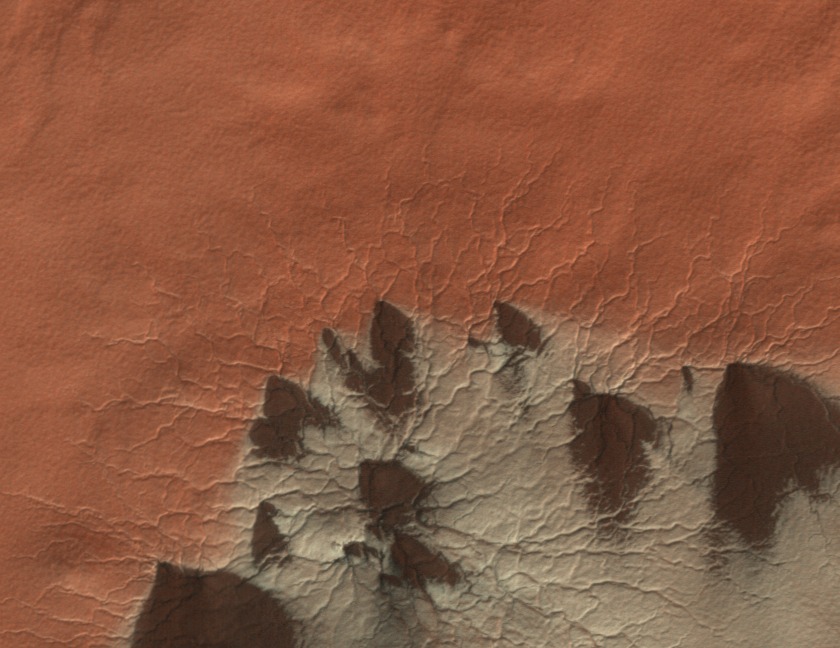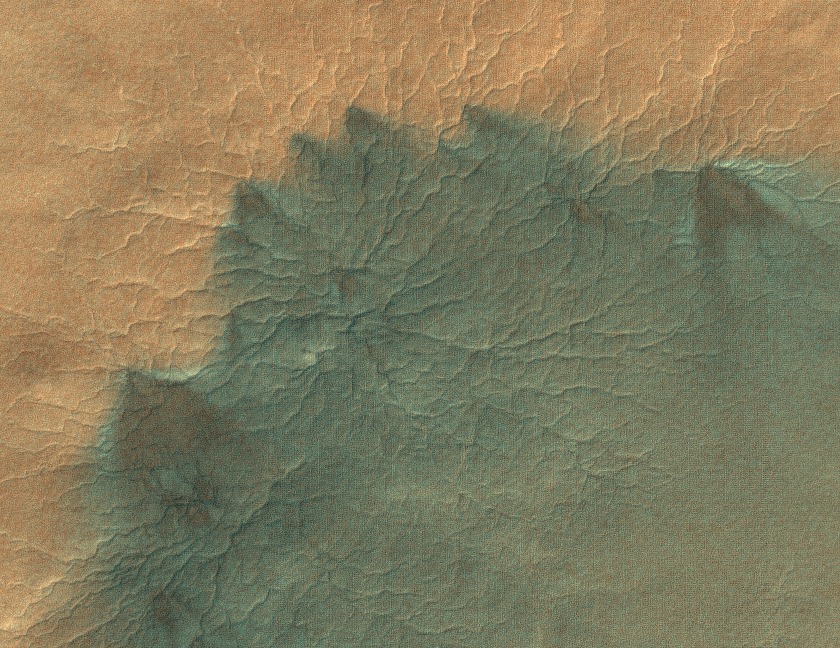Chicken or Egg?
-
 by
wassock
moderator
by
wassock
moderator
Can one of the science team say what the time interval between these two is please:

and

Same Spider different colours - but the surface is also a different colour so is the colouration of the fans just down to the camera filters?
Posted
-
 by
JellyMonster
by
JellyMonster
Good spot. As you say, looks identical apart from the colouring.
Posted
-
 by
mschwamb
scientist, translator
in response to wassock's comment.
by
mschwamb
scientist, translator
in response to wassock's comment.
My guess is the 2nd image is later on in the season, but I can check. If you give me the APF numbers I can tell you the observation dates and Ls (solar longitude).
Cheers,
~Meg
Posted
-
 by
wassock
moderator
by
wassock
moderator
Hi Meg the numbers are APF00003ea and APF00003he (and APF00003lp is also the same spider) I'm assuming they are both from the same year and in the order you suggest. Are you able to identify a pic of the same area in a different year?
I found another pair APF00003il and APF00003dk
Posted
-
 by
wassock
moderator
by
wassock
moderator
APF00003GH makes the 2nd pair a trio -NOPE JUST SIMILAR
Posted
-
 by
wassock
moderator
by
wassock
moderator
APF00003LB makes it 4 NB SIMILAR ALSO not a match
Posted
-
 by
mschwamb
scientist, translator
in response to wassock's comment.
by
mschwamb
scientist, translator
in response to wassock's comment.
Here you go - I believe on the bottom of these pages it tells you links to images taken close to the same area
APF00003ea ==> ESP_011526_0980
APF00003he ==> ESP_011737_0980
APF00003lp ==> ESP_012515_0980
APF00003il ==> ESP_011737_0980
APF00003dk ==> ESP_011526_0980
APF00003GH ==> ESP_011526_0980
APF00003LB ==> ESP_011737_0980
Cheers,
~Meg
Posted
-
 by
wassock
moderator
by
wassock
moderator
Meg - SHOCK RESULT!
APF00003ea 10 Jan 2009

APF00003he 27 Jan 2009

APF0000lp 28/3/09

So the Green colouration prceeds the very dark fans on a white background - Or is this just a filter isue, the surrounding ground changes colour too.
Posted
-
 by
wassock
moderator
by
wassock
moderator
Assuming there's not been some dreadful mix up with the indexing of the Hi-Rise images could the faint fans visible in the first green image be the ghosts of the previous years fans showing through the transparent ice layer? I have a couple of images of the summer residue seperated by 3 years which shows a consitency of where the fans are - need to get on a PC to crop the images to a sensible size to post here.
Posted
-
 by
wassock
moderator
by
wassock
moderator
This is the 2012 image (30 december) http://hirise.lpl.arizona.edu/ESP_030132_0980
The spider is fairly easy to find in the summer 2009 image at http://hirise.lpl.arizona.edu/ESP_012515_0980 Almost dead center on the big image.
Same again here for the early 2009 image http://hirise.lpl.arizona.edu/ESP_011526_0980NB I'd suggest you open the RGB images
Posted
-
 by
Kitharode
moderator
in response to wassock's comment.
by
Kitharode
moderator
in response to wassock's comment.
Wassock. Been following image links ok so far and I'm with the story so far. Fascinating stuff. But in your last post the 'easy to find' / 'dead centre' spiders elude me. One image has a bit of spider in the top-left corner, but the rest of the image is pretty 'blank'. You say "dead centre on the big image" - should I go somewhere else from the link in your post to reach the 'big image'?
Posted
-
 by
wassock
moderator
by
wassock
moderator
Sorry not the big image at the top scrolldownand find a whole bunch of further links and all the time and location data.open up the RGB one
Posted
-
 by
wassock
moderator
by
wassock
moderator
Jan 09
Posted
-
 by
wassock
moderator
by
wassock
moderator
So I AM SUggesting that the first 2 images are summer ones with no ice and the remains of the fans from the spring still visible. Note the consistency of the location of the dark bits between the 2. The last, green image is early spring and,ses me, shows a largely unvented ice layer with last years dark bits visible through it. Looks like vents may have just started here, more so than in the green one from the first set of images in this thread.
Posted
-
 by
Kitharode
moderator
by
Kitharode
moderator
Got the RGB images. Thanks for that and well done on finding them in the first place. I think definately need a scientist to clarify the colour-filter situation. It sounds important.
Other than that, your observations look good to me and I can go along with them easily. I'm sure I've recently read an article with a few paragraphs that pretty well describe what you're talking about. Something about fans settling and 'sinking' into the ice. If I can find it again I'll post it. Basically, you're onto something good here I think.
Late Edit: "Every spring dark fan-shaped deposits are observed on top of the seasonal ice, which then slowly blend into the darkening background as the season progresses". There's more later in the article (I think).
On the off-chance you've not seen the article (and for any newcomers passing by) it's got lots about spiders and fans, with some great images included. It'll also explain (to those who don't know) what 'Inca City' and 'Manhatten' have to do with spiders on Mars.
Posted
-
 by
wassock
moderator
by
wassock
moderator
Kith, I'm suggesting that the ice top fan stays in situ when all the ice has melted and the the next years ice forms on top. Come the spring, before theres any venting, the remains of the fan from the previous year can still been seen through the ice.
Posted
-
 by
Kitharode
moderator
by
Kitharode
moderator
Yes, I can see how you see that. It's very plausible to me and I think you have it right, for what that's worth. My 'ice wedge' investigations are leading me towards a much thinner layer (at spider fanning time) than I'd been imagining before. Perhaps a very few centimetres at most. It's also gonna be pretty see-through also (maybe). Seeing dark 'shadows' should be really easy (he said confidently).
If you can find that PC you were looking for earlier and you're able to do some image magic, I'd love to see your 'story' in pictures and commentary combined.
Posted
-
 by
Kitharode
moderator
by
Kitharode
moderator
First approximation of ice thickness in early spring, between latitudes 75 and 84 deg (spiderland).
Viewing the icelayer as a perfect wedge, the thickness between these latitudes is 0cm to 28cm.
I'm posting my method of calculation in my 'Spiders by Latitude' thread (after some sleep!).
Posted
-
 by
Portyankina
scientist
in response to wassock's comment.
by
Portyankina
scientist
in response to wassock's comment.
I think a lot of colour difference is from filters plus atmospheric contamination of the first image. However, bright halos around dark "centres" of fans are everywhere appearing on the place of previously more extended dark fans. We have couple of hypothesis how those could form but nothing definitive. The idea of looking trough the ice onto the previous year deposits crossed our minds too, but in many areas we could see no traces of fans in summer. Also, from spectrometers we know that CO2 is covered by dust in those first images, while later with blue halos we see increase of the CO2 signal - this tells us, those bluish fans must be fresh CO2 somehow overlaying the dark fan that was there before.
Anya
PS I am sorry if you already know all this, I lost the track how many times I told this and to who! 😃
Posted
-
 by
wassock
moderator
in response to Portyankina's comment.
by
wassock
moderator
in response to Portyankina's comment.
Anya, the greeny blue fans come first, the very dark ones come later.
Posted
-
 by
Portyankina
scientist
in response to wassock's comment.
by
Portyankina
scientist
in response to wassock's comment.
I meant these APF00003he blue fans around dark ones. This kind of blue halos we see created on place of former dark fans. Basically, what I am trying to tell here is that your blue-green fans are already in process of turning from totally dark fan that was there before (even earlier in spring than this image was taken) to the bright blue fans of the image APF00003he.
Posted
-
 by
wassock
moderator
in response to Portyankina's comment.
by
wassock
moderator
in response to Portyankina's comment.
Sorry you've lost me, and you posted the same image thrise.
The one you posted above, APF00003he shows very dark fans over a white frosting.APF00003ea shows the same area as diffuse fans over a greeny blue frost. But the green one is dated a week before the dark/wh7te one.Not sure where the halos you mention are?
Posted
-
 by
Portyankina
scientist
in response to wassock's comment.
by
Portyankina
scientist
in response to wassock's comment.
Sorry, one more try:
Before image APF00003ea (green and hazy) there was time when whole fans' area was dark. Then brighter (green/blue) fan halos started to develop. First they turned to green and then to bright blue from APF00003he (red background+blue halos+dark fans).
Hopefully this explanation is better 😃 The quality of image APF00003he is so much higher, the color contrast might be way off compared to APF00003ea.Anya
Posted
-
 by
wassock
moderator
by
wassock
moderator
Anya I don't see any blue anywhere in APF00003he, do I need to get a test from Dr Ishihara?
Question I should have asked is are the colour settings the same for all 3 images? Or are the varying colours down to filters and processing?
Posted
-
 by
wassock
moderator
by
wassock
moderator
For Kitharode and PaulMetcalfe - you both just commented on Image APF0000m2t which is from the same/similar area as the images above - I did this before we had easy access to the HiRise images so may be I need to revisit thisone - enjoy
EDIT having revisited a bit I realise that these images are also from the same chunk of mars as the Heart - may even be the heart!Posted
-
 by
Kitharode
moderator
in response to wassock's comment.
by
Kitharode
moderator
in response to wassock's comment.
Ahhh ... Those early days. I remember this very well. 😃
Posted